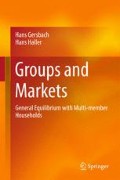Abstract
We provide a cursory overview of club models, which also deal with an endogenous partition of the population into groups. We identify common and distinguishing features between club models and household models. We further elaborate on two-sided pairwise matching, a special case of group formation in the absence of commodity markets. The effect of active commodity markets on equilibrium existence and welfare is investigated.
-
Club models and household models are not nested.
-
The general framework encompasses matching, assignment games and hedonic coalitions.
-
In the presence of active commodity markets, stable matching and market clearing need not obtain simultaneously.
Access this chapter
Tax calculation will be finalised at checkout
Purchases are for personal use only
References
Alkan, A. (1988). Nonexistence of stable threesome matchings: Note. Mathematical Social Sciences, 16, 201–209.
Alkan, A., & Gale, D. (1990). The core of the matching game. Games and Economic Behavior, 2, 203–212.
Banerjee, S., Konishi, H., & Sönmez, T. (2001). Core in a simple coalition formation game. Social Choice and Welfare, 18, 135–153.
Bogomolnaia, A., & Jackson, M. O. (2002). The stability of hedonic coalition structures. Games and Economic Behavior, 38, 201–230.
Buchanan, J. M. (1965). An economic theory of clubs. Economica, New Series, 32(125), 1–14.
Cole, H. L., & Prescott, E. C. (1997). Valuation equilibrium with clubs. Journal of Economic Theory, 74, 19–39.
Drèze, J., & Greenberg, J. (1980). Hedonic coalitions: Optimality and stability. Econometrica, 48, 987–1003.
Ellickson, B. (1979). Competitive equilibrium with local public goods. Journal of Economic Theory, 21, 46–61.
Ellickson, B., Grodal, B., Scotchmer, S., & Zame, W. R. (1999). Clubs and the market. Econometrica, 67, 1185–1218.
Ellickson, B., Grodal, B., Scotchmer, S., & Zame, W. R. (2001). Clubs and the market: Large finite economies. Journal of Economic Theory, 101, 40–77.
Gale, D. (1984). Equilibrium in a discrete exchange economy with money. International Journal of Game Theory, 13, 61–64.
Gale, D., & Shapley, L. (1962). College admissions and the stability of marriage. American Mathematical Monthly, 92, 261–268.
Gersbach, H., Haller, H., & Konishi, H. (2015). Household formation and markets. Economic Theory, 59, 461–507.
Gersbach, H., & Haller, H. (1999). Allocation among multi-member households: Issues, cores and equilibria. In A. Alkan, C. D. Aliprantis, & N. C. Yannelis (Eds.), Current trends in economics: Theory and applications. Heidelberg: Springer.
Gersbach, H., & Haller, H. (2001). Collective decisions and competitive markets. Review of Economic Studies, 68, 347–368.
Gersbach, H., & Haller, H. (2010). Club theory and household formation. Journal of Mathematical Economics, 46, 715–724.
Gersbach, H., & Haller, H. (2011). Competitive markets, collective decisions and, group formation. Journal of Economic Theory, 146, 275–299.
Gilles, R. P., & Scotchmer, S. (1998). Decentralization in club economies: How multiple private goods matter. In D. Pines, E. Sadka, I. Z., (Eds.), Topics in public economics: Theoretical and applied analysis, Chap. 5. Cambridge, UK: Cambridge University Press.
Gilles, R. P., & Scotchmer, S. (1997). Decentralization in replicated club economies with multiple private goods. Journal of Economic Theory, 72, 363–387.
Greenberg, J. (1978). Pure and local public goods: A game-theoretic approach. In A. Sandmo (Ed.), Essays in public economics. Lexington, MA: Heath and Co.
Hall, P. (1935). On representatives of subsets. Journal of the London Mathematical Society, 10, 26–30.
Jacobs, K. (1969). Selecta mathematica I. HTB 49. Heidelberg: Springer.
Maak, W. (1935). Eine neue definition der fastperiodischen funktionen. Abhandlungen aus dem Mathematischen Seminar Hamburg, 11, 240–244.
Quinzii, M. (1984). Core and competitive equilibria with indivisibilities. International Journal of Game Theory, 13, 41–60.
Roth, A. E., & Sotomayor, M. A. O. (1990). Two-sided matching: A study in game-theoretic modeling and analysis. Cambridge, UK: Cambridge University Press.
Shapley, L. S., & Shubik, M. (1972). The assignment game I: The core. International Journal of Game Theory, 1, 111–130.
Tiebout, C. M. (1956). A pure theory of local expenditures. Journal of Political Economy, 64, 416–424.
Weyl, H. (1949). Almost periodic invariant vector sets in a metric vector space. American Journal of Mathematics, 71, 178–205.
Wooders, M. H. (1988). Stability of jurisdiction structures in economies with local public goods. Mathematical Social Sciences, 15, 29–49.
Wooders, M. H. (1989). A Tiebout theorem. Mathematical Social Sciences, 18, 33–55.
Wooders, M. H. (1997). Equivalence of Lindahl equilibrium with participation prices and the core. Economic Theory, 9(2), 115–127.
Author information
Authors and Affiliations
Corresponding author
Rights and permissions
Copyright information
© 2017 Springer International Publishing AG
About this chapter
Cite this chapter
Gersbach, H., Haller, H. (2017). Clubs, Matching, etc.. In: Groups and Markets. Springer, Cham. https://doi.org/10.1007/978-3-319-60516-6_9
Download citation
DOI: https://doi.org/10.1007/978-3-319-60516-6_9
Published:
Publisher Name: Springer, Cham
Print ISBN: 978-3-319-60515-9
Online ISBN: 978-3-319-60516-6
eBook Packages: Economics and FinanceEconomics and Finance (R0)

